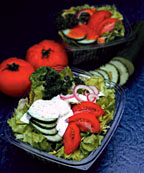
Understanding Functions and Cost
Xanthan gum is the hydrocolloid of choice for many oil-and-water emulsions, and foods with low pH. Products such as salad dressings and sauces are particularly well-suited for this gum, as it provides excellent cling; this is attributed to its very high yield value, explains Mark Freeland, commercial development manager, Rhodia Food, Cranbury, N.J. Xanthan gum also is a very pseudoplastic (shear-thinning) hydrocolloid, so, when dressings, sauces and toppings are poured onto a food, such as a salad, the dressing will cling nicely to the salad greens and coat them evenly.Guar gum also can be used in sauces, toppings and in some dressings, in combination with xanthan gum and/or starches, providing a product of excellent quality at an economical cost.
In many bakery products, such as cakes, muffins and pancakes, hydrocolloids assist in retaining moisture, which extends the shelf-life. Additionally, hydrocolloids add viscosity to the batter, which controls the size of the air cells, created by the reaction of the leavening acid and sodium bicarbonate, resulting in better volumes and finer texture.
An increasingly important function for hydrocolloids is improving the freeze-thaw stability of many foods. Xanthan gum, guar gum, locust-bean gum and carrageenan provide excellent freeze-thaw stability to many frozen food products. As more and more food products are provided to consumers in a frozen format, freeze-thaw stability will become more critical for frozen doughs, entrees, pizzas and many other products.
Expenses have become a very critical issue for the food manufacturer today. Sometimes the concept of cost in use is not completely understood. When one is evaluating the price of the hydrocolloids package for a particular food product, the cost per pound for each ingredient should be looked at from the view of “what does it cost in the finished product?” A more expensive product on a per pound basis may be used at lower levels in the formulation and, actually, result in lower costs. Besides overall expenses, formulators also need to evaluate the quality, stability and overall consumer acceptance of the product in order to understand the true value of the hydrocolloids package in the food product. Cheapest is not always the best.
Manufacturing Tips
In addition to reviewing hydrocolloids' functional properties, manufacturers need to consider how they will be utilized. Questions that should be entertained include, “Is our process a cold or hot process?” and “Is our manufacturing equipment capable of handling the chosen hydrocolloids package?”Guar and xanthan gum are cold-soluble hydrocolloids, which means their viscosity develops as soon as they come into contact with water. That being the case, good mixing equipment, or making a hydrocolloid/oil slurry, helps ensure good incorporation—without getting lumps. Another approach for these cold-soluble hydrocolloids is a coarser particle size or even agglomeration of the hydrocolloids, as this will improve their dispersibility and reduce the tendency to lump. Also, these types of products are less dusty.
Heat is required to activate locust-bean gum and carrageenan (except for lambda-type carrageenans, which are cold-soluble). These two hydrocolloids need to be heated to between 175 to 185°F, to ensure complete development.
Many factors influence the choice of hydrocolloids used in food products, so please feel free to contact the experts at Rhodia.
For more information:
Mark Freeland at 609-860-4515
mark.freeland@us.rhodia.com • www.food.us.rhodia.com
Rhodia Inc. Write in 228